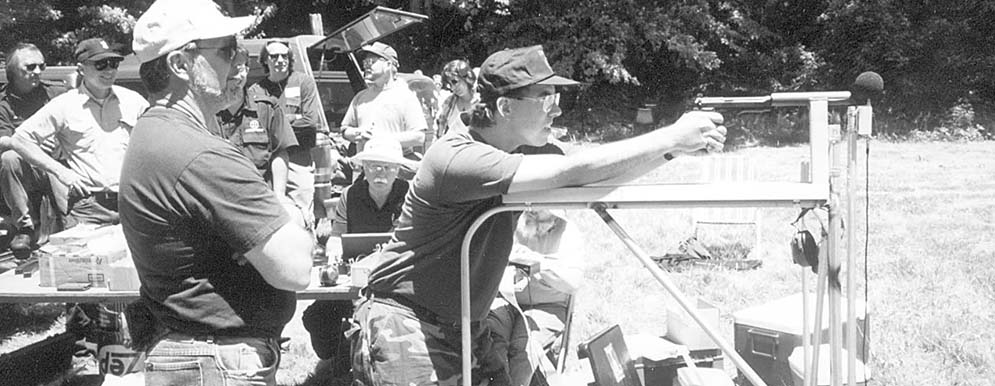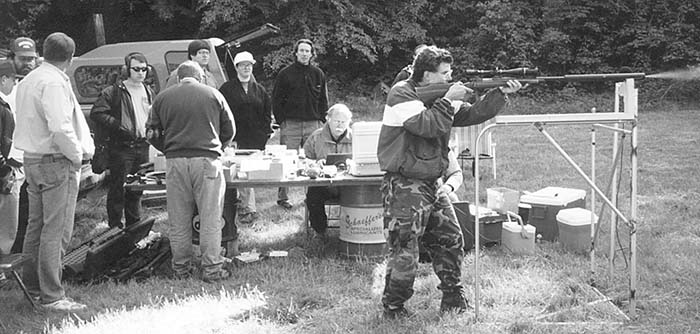
By Matt Smith
Small Arms Review is sponsoring the 1999 Suppressor Trials to be held October 5 and 6 in West Point, Kentucky. These dates are the Tuesday and Wednesday immediately preceding the fall 1999 Knob Creek Machine Gun Shoot and Show. It has been two years since the last Suppressor Trials, held May 22, 1997. Once again, our Suppressor Technology Editor, Al Paulson, will be supervising the sound testing. All like units will be tested at the same time of the day and in sequence. For example, all Mark II pistols by all manufacturers will be tested one after another, then 10/22’s, etc.
Testing will include ten shot strings with decibel measurements, chronographing and benchrest shooting for accuracy. The equipment used will include two sound meters including a Larson Davis Model 800-B sound meter with Larson Davis 2530-1133 1/4 inch random incidence microphone and automated data recording using a Hewlett-Packard OB-425 computer and software developed by Dr. Phil Dater. The second meter will be a B & K 2209 with a 1/4 inch 4136 pressure microphone. Both meters will be calibrated prior to the trials to NIST specifications. A custom-testing frame, which cradles the muzzle of each weapon one meter to the right of the microphone will be used to maintain consistency in testing. Chronographing will be accomplished with a P.A.C.T. MK IV timer/chronograph with MK V skyscreens set 24 inches apart with the start screen 8 feet from the muzzle. The trials will be closed to the public with environmentally controlled ammunition and test firing provided by SAR staff volunteers.
The 1997 Suppressor Trials was an unprecedented event where a majority of U.S. suppressor manufacturers and representatives assembled at the Knob Creek Range to test their varied products on the same equipment. Many lessons were learned that day and based on feedback provided by participants and staff, testing enhancements have been added to the 1999 Suppressor Trials. The day that had been set up for sixty tests in 1997 turned into a long day of 163 test strings. Valuable data was obtained and information was exchanged by many of the participants. Two days have been set aside for the 1999 Suppressor Trials to assure that every interested manufacturer has ample time to test their products, and to reduce wear on the testers.
Participating manufacturers in the 1997 Trials included Don Austin Wagenknecht, Engel Ballistic Research, Gemtech, John’s Guns, Jonathan Aurthur Ciener, JRW Sports, Knights Armament Company, R.A.S.E., S & H Arms of Oklahoma, Sound Technology, Special Ops Shop, Summers Machine Enterprises and SWR. In addition, there were suppressors tested that were manufactured by AWC Systems Technology, John Norrell, SIOPTS, HEL, Precision Arms, Military Armament Corp., Larand, and factory HK.
The suppressor testing was preceded by taking sound measurements of unsuppressed weapons for comparison purposes. Data collected included the host firearm type, barrel length, name, and type of the suppressor, caliber and type of ammunition (including supersonic and subsonic), the chronographed velocity in feet per second, the ambient temperature (which started at 51 degrees farenheight in the morning to as high as 85 degrees in the middle of the day), the mean sound pressure level, the net sound reduction and the first round pop (all expressed in decibels).

Tested weapons included the Ruger 10/22, 96 rifle (.44), Mark II pistol, 77/.223, 22/45, 77/22, H & K MP5, Mk23 pistol (.45) Glock 17, Mountain Eagle pistol, Colt M16A2 (M4 (14.5” and 20”), Remington M700 (.223) .308, 541T (.22), M788 (.223), Cobray M11/9mm, Beretta 92 F, Smith and Wesson 422, High Standard .22 pistol, Marlin 39A .22 rifle, 880 .22 rifle, and (9mm and .45), Savage 110FP (.308), King 522 bolt action .22, Makarov .380, Bersa .22 pistol, Sako .300 Whisper, Walther TPH and PP .22 pistols, Stechkin .380 pistol, Ramline Exactor .22 , and a Carl Gustav M45 9mm submachine gun. Suppressor types included muzzle cans, integral suppressors, wet or artificial environments and dry suppressors.
Ammunition provided by Dan Shea included Remington high velocity .22 LR for integral suppressors, Remington Subsonic .22 LR for .22 muzzle cans, Maine Cartridge Company 9mm 147 grain subsonic for 9mm muzzle cans, and Winchester USA (White Box) ammunition in 9mm, 115 grain, .45 ACP 230 grain, .223 55 grain, and .308 147 grain. Whit Engel of Engel Ballistic Research provided subsonic .223 ammunition for testing.
Ammunition for the 1999 Suppressor Trials will be provided by SAR and will be commercially available ammunition of various calibers with ample supply from the same lot of each type for the two days of testing. The ammunition will be stored in a temperature-controlled environment throughout the tests and will be loaded just prior to each 10 shot string. Only NFA registered suppressors will be allowed at the trials. The test data collected will be the property of SAR and will be published in a manual following the tests. Special arrangements can be made for unique circumstances regarding non-public data. Pre registration of units to be tested should have been done by 1 September 1999. There will be a $25 fee for each test administered. Any manufacturers or military/Law Enforcement procurement/user personnel who missed the 1 September deadline, please contact:
Small Arms Review
223 Sugar Hill Road
Harmony, ME 04942
Phone: (207) 683-2959
Fax: (207) 683-2172
Email: sareview@aol.com
| This article first appeared in Small Arms Review V3N1 (October 1999) |










